-

人教版高中英语必修4A taste of English Humor说课稿3篇
Then I would ask them to think of a funny English or Chinese and tell it to partners. While telling stories, they can use expressions and some acting to help make the story funny. 5 minutes would be given to do this.Those stories they told there will be the material for their writing. Soletting them tell it at first is helpful. And they can make a difference between telling a funny story and writing it down. Generally speaking, it is difficult forstudents to write well because they don’t know what to write and how to write. Asking them to tell their own stories at first can help them come up with what to write.After their telling, I would invite someone to share his/her story with all of us and I would write it down on the blackboard.This example story would be used as a sample to illustrate the format of funny story. Different from a story from teacher or textbook, a story from students can obviously become a interesting material to draw students’ attention.Then I would ask the whole class to put this story into several parts. It might be a little bit difficult for them. So I would ask them to find out whether all the sentences are necessary. After delete some sentences, there are 6 sentences left behind. Then they can easily put them into three parts. After interaction with students, I would teach them the right terms for each part and conclude the format of funny story.This step is the key and difficult point in my lesson. So I mainly usetask-based teaching method in this part and the task for students was divided into several stages. With the separated difficult level, students can find there are usually three parts in writing. They can also learn to write without the unnecessary parts in the process of analyzing. And then I wouldn’t rush to tell them the right terms to them directly. Instead, I would ask them to name them by their own. A confused mind is better for acquiring knowledge.While-writing:Then I would give students 7 minutes to write down this story, without other requirements.With all the preparations in pre-writing, students’ difficulties were cleared. So it would be much easier for them to write down the story within 7 minutes. There are no other requirements because students’ first writing is actually a drafting. It would be revise and edit several times later. Writing, as a skill

人教版高中英语必修3Festivals around the World说课稿3篇
Teaching plan for Unit 1 book3Good morning, teachers. It’s my great pleasure to be here because I can share my lesson with you and I can learn a lot from it. I’ll begin my lesson from the following four parts, the teaching material, the teaching methods, the studying methods and the teaching procedure.Firstly, let me talk about the teaching material. The content of my lesson is the reading passage festivals and celebrations of Unit 1 Festivals around the world. This passage is about festivals and celebrations. By studying this passage, we’ll enable the students to know that festivals exit everywhere, and many of festivals in different countries celebrate similar ideas. As we all know, the reading passage is the center of each unit. If the Ss can learn it well, it will be helpful to make the Ss learn the rest of this unit.After studying the teaching material, I think the teaching aims are as the followings:1. Knowledge aims:(1) The Ss can master the usage of the important words andexpressions.(2)The Ss can use the __________________ (grammar) in the proper situation.Make students know about the festivals all over the world and the detail of the festivals, such as origin, content, and the date of the holiday festivals.2. Ability aims:(1) Students can talk about festivals and celebrations in English(2) To improve the student’s reading ability, especially their skimming and scanning ability.3. Emotion aims:Make the Ss know about the foreign festivals, and respect other countries’ custom.Next, let’s come to the important points and the difficult points.The important point is how to make the Ss understand the text better and the difficult point is how can they talk about it. secondly, Teaching Methods:1. task-based Language Teaching2. Computer assisted language teaching.3. question-and–answer methodThirdly, Studying Methods:

人教版高中英语必修4Working The Land说课稿3篇
Knowledge objectives:(1) to make Ss grasp the usage of words, expressions and sentence structures: statistics, struggle, thanks to, rid of, some patterns for persuasion, the “ing” form as subject and object;(2)to use learnt knowledge to persuade sb.Ability objectives:(1) to develop Ss’ reading skills(skimming, scanning, word guessing);(2) to improve Ss’ speaking, communicating and cooperating skills.Emotional objectives:to make Ss know the contribution of Yuan,and learn his spirit and his simple life time.Teaching important and difficult points:(1) some words, expressions and sentence structures mentioned above;(2)the content of the text;(3)training their reading and speaking skills.Teaching methods: CLT, TBLT,QT.Learning strategies: CLS, QLS, TBLS.Teaching procedures:Step 1 lead-in: (1) teacher plays a piece of recent news from CCTV about the harvest of the super hybrid rice, and ask students whether they know Yuan or not, and talk about him and his contribution.(2)Brain storm: let Ss describe Yuan in their minds including his appearance, his living condition and so on.Step 2 fast reading tasks:(1)teacher introduces Yuan and super hybrid rice(2)make Ss read the text as fast as possible with questions. Such as: what’s the general ideaof this passage? What’s Yuan’ dream? (skimming and scanning skill)Step 3 intensive reading tasks(1)let Ss read the text silently, find topic sentence of each paragraph and draw the difficult sentences and the knowledge what they don’t understand.(words guessing)(2)teacher and Ss talk about the important words, expressions and sentences together, and ask Ss to retell the content of the text.(summarizing and paraphrasing)(3)teacher summarize this part.(4) read again following the courseware.

人教版高中英语必修5Great scientists说课稿4篇
通过写文章梗概,培养学生综合运用语言的能力,学习用恰当的英语描述科学家的故事。这是本课的教学难点。教师可以使用完形填空的方式来帮助学生整理语篇,从而来降低难度。本课的教学重点的突破方法是:在阅读前,让学生初步了解得出科学观点所需要的基本程序,从而轻松而自然地导入文章的阅读;在阅读过程中,由易到难设计快速阅读和精读的问题,层层推进各种阅读活动,让学生对阅读内容从整体感知到细节理解,最后深层读懂整篇文章,同时加强阅读策略的指导,让每个学生都主动参与课堂教学活动,最终达到提高阅读能力的目的。Step 4 Post-readingGroup Activities四人小组共同合作,在老师的适当指导下,就以下2个问题展开讨论,让学生就所知、所学、所感和所想融入话题,然后抽若干同学代表作小组发言。1. What do you think about John Snow, and what should we learn from him?2. Cholera was 19th century disease, which two diseases are similar to cholera today? Why?

人教版高中英语必修5The United Kingdom说课稿4篇
Teaching Aims:Knowledge 1. Get the students to learn the useful new words and expressions in this section. Aims:2. Let the students learn about how the UK was formed and the four groups of invaders.1. Develop students’ reading ability and let them learn different Ability reading skills. Aims:2. Enable students to learn to talk about the United Kingdom and the Union Jack Emotional 1. Let students know more about the UK2. Develop students’ sense of cooperative learning Aims:Teaching Important Points:1. Let the students learn about the countries of the United Kingdom and the Union Jack2. Get the students to read the passage and know about how the UK was formed and the four groups of invaders.3. Have the students learn different reading skills.Teaching Difficult Ponts:1. Develop students’ reading ability.2. Enable students to talk about the United Kingdom and the Union Jack.3. Let students learn how the UK was formed geographically and historically.Teaching Methods:Showing pictures, asking, exercising, listening, reading etc.Teaching Aids:A computer,a projector and a blackboard.Teaching Procedures: 1) Show a map of the world, ask students the following questions:Where is the UK?What’s the full name of the UK?2) Ask the students work in pairs to do the quiz on Page 9.Do you want to test how many things you know about the United Kingdom? Let’s have a small test.Using the map on P9, students answer the following questions:?How many countries does the UK consist of? What are they??England is divided into three main areas. Do you know what they are? 1) Scanning (10Minutes )Let the students hold the questions asked in pre-reading and read the passagequickly and then let them do the following exercise.Join lines to the right answer.
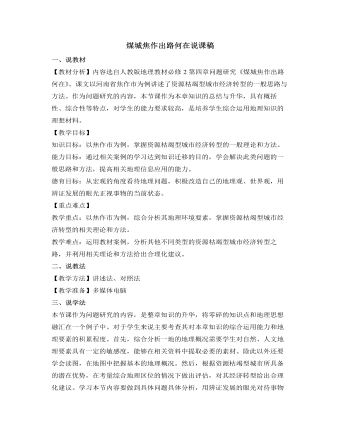
人教版高中地理必修2煤城焦作出路何在说课稿
分析过焦作市的地理概况和产业优势后,就需要针对由于资源枯竭所带来的问题提出合理化的建议。既然是谈经济转型,就应该将话题的范围明确在这一领域内。通过材料3的相关内容,我们了解到焦作市需要在产业结构调整、培育新的优势产业、增强综合竞争力等三个整改方针上下功夫。因而引导学生针对优势与不足提出建议,以三个整改方针为基准,衡量建议的可行性是锻炼学生解决此类问题的有效途径。在此我将教会学生的是解决问题方法而非案例的内容,正所谓“授之以鱼,不如授之以渔”。接下来针对学生的建议和教材资料分析所罗列的10点整改思路,由学生自由发言提出看法,通过教师的指导和学生的讨论,进而确定经济转型建议的具体方案。最后注意将建议与产业优势相对照,看建议是否都是围绕着产业优势而提出的,这样做会加深学生的印象,通过建议和优势的对应关系,将不难找出此类问题的解题思路。
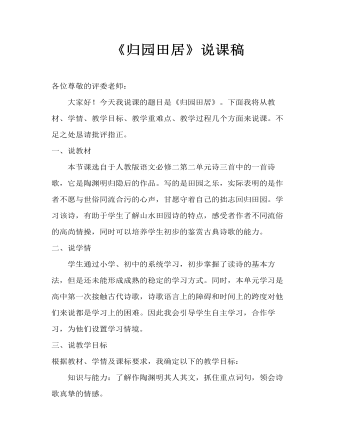
高中语文人教版必修二《归园田居》说课稿
一、说教材本节课选自于人教版语文必修二第二单元诗三首中的一首诗歌,它是陶渊明归隐后的作品。写的是田园之乐,实际表明的是作者不愿与世俗同流合污的心声,甘愿守着自己的拙志回归田园。学习该诗,有助于学生了解山水田园诗的特点,感受者作者不同流俗的高尚情操,同时可以培养学生初步的鉴赏古典诗歌的能力。

人教版高中语文必修1《纪念刘和珍君》说课稿3篇
1.说教材《记念刘和珍君》是鲁迅先生用饱醮着热泪,用悲愤的笔调写下的一篇感人至深的散文,既有对爱国青年沉痛的悼念,又有对反动派愤怒的控诉,也有对觉醒的国民的呐喊。《记念刘和珍君》是高中语文必修1第三单元第一课的讲读课文。文中描摹人物的音容笑貌,叙述人物的行为事迹,都融入了作者真挚的情感和深刻的感悟。对学生明辨是非,领悟时代精神和人生意义,有着重要的作用。新课标强调了要全面提升高中学生的语文素养,初步形成正确的世界观、人生观、价值观,并学会收集、判断、处理信息,具有人文素养、创新精神与实践能力。同时,《记念刘和珍君》感情真挚,感悟深刻,具有典型人文性。结合本单元教学目标,确立教学目标如下。
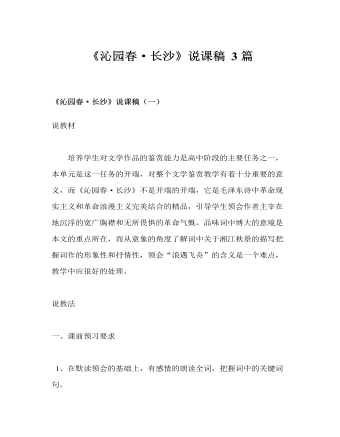
人教版高中语文必修1《沁园春·长沙》说课稿3篇
4、学习全词:(1)背景介绍,让学生看课文中的年代,然后让学生回忆1925年的毛泽东的情况,老师适当提示,让学生了解其背景。(出示幻灯片)(2)学生自由朗读,结合注释和背景理解诗词。(3)师生共同理解全词①先让学生齐读前三句,思考正确的语序,并用正常的语序解释。②品味第三到第十句,这里是教学的一个重点,要让学生先读,再理解,在此基础上训练学生的想象能力。③分析上阙中的最后三句。④小结上阙。提出了一个问题“谁主沉浮”让学生在文中找内容回答,然后转入下阙内容的分析。⑤分析下阙内容,回答“谁主沉浮”的问题,突出本文主旨5、描绘诗词形象:学生用自己的语言把上阙的内容生动地描绘出来。6、欣赏学生优秀作品。(根据时间具体而定,也可以作为课后作业)
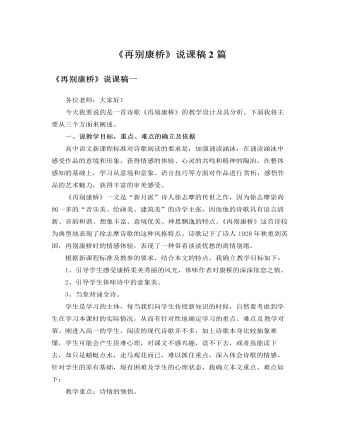
人教版高中语文必修1《再别康桥》说课稿2篇
一、教材分析1、教学对象分析《再别康桥》的教学对象是高一学生,高一学生往往对那种纯粹的、原始的、本真的情感体会较为肤浅,《再别康桥》是新月派诗人徐志摩的传世之作,有极高美学价值,它所抒发的离愁别绪是人类共同的情感经历,通过诵读容易将学生带人诗境,唤醒他们沉寂的真情,从而引起强烈的共鸣。 2、教材地位及作用 高中语文第一册第一单元为诗歌单元,本单元收录了中国现当代的一些优秀诗篇。《再别康桥》安排在本单元的第二课,属于必读课。虽然本诗向来众说纷纭,但其艺术之美人所共知,培养学生高尚的审美情趣和良好的审美创造力是语文学科的任务,因此,从语言赏析入手,从情感体验切入,就可以让学生通过学习本课体会现代诗歌的特点,多方面感受体悟诗歌的情感,受到美的熏陶。
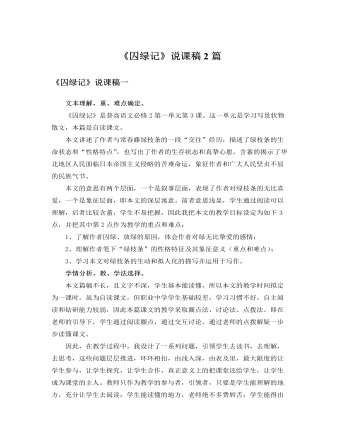
人教版高中语文必修2《囚绿记》说课稿2篇
“深入探究,把握主旨”这一步则是解决教学的重点难点,这里涉及到课文的深层意蕴,学生理解有难度,教师在通过问题引领学生探讨的基础上,还要适时启发、点拨,因为教学时间有限,让学生漫无边际的讨论,可能难以完成预定的教学任务,会使教学过程不完整。至于本文的写作特点的教学视时间而定,有时间可以让学生说一说,没有时间用小黑板出示一下,让学生了解就行,如果时间不够,甚至可以不讲。第三阶段是“延伸练习,巩固提高”。
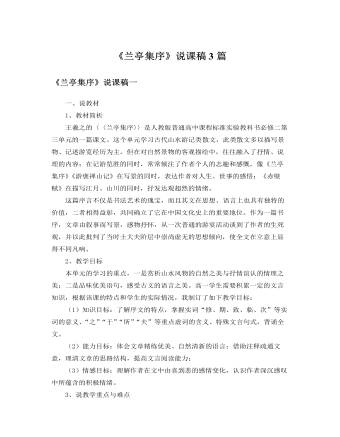
人教版高中语文必修2《兰亭集序》说课稿3篇
(二)分析课文,理清思路第1、2段为第一部分,主要是叙事、写景,先叙述集会的时间、地点,然后渲染出兰亭优美的自然环境。在这里足以“游目骋怀”“极视听之娱”,可以自由地观察、思考,满足人们目视耳闻的需求。这里正是与会“畅叙幽情”、尽兴尽欢的绝好处所。这些描写都富有诗情画意,作者的情感是轻松愉快的。第3、4段为第二部分,主要是抒情、议论,作者由美景妙时引发出乐与忧、生与死的感慨。他认为人生的快乐是有极限的,待快乐得到满足时,就会感觉兴味索然。往事转眼间便成为历史,人到了生命的尽头就会死亡。作者由“一死生为虚诞,齐彭殇为妄作”的认识,产生了一种珍惜时间、眷恋生活、热爱文明的思考。虽然文中的寿夭、生死不能自由决定,从而有些伤感,但作者仍然认识到盛衰、生死是必然的。人生无常,时不我待,故著文留传后世,以承袭前人,启示来者。
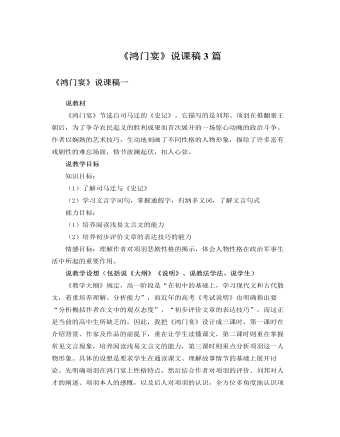
人教版高中语文必修1《鸿门宴》说课稿3篇
3、拓展延伸,启迪心智,创设课堂训练营。三、说学法1、纸上得来终觉浅,圈点、勾画、批注法,学好文言基本功。2、自主合作加探究,眼耳口脑手并用,破疑解难在其中。四、说课时安排《鸿门宴》篇幅较长,文言知识较丰富,文章内涵丰厚,因此我设计用五课时教学本文。第一课时:了解作家作品,积累文言知识,感受作者隐忍发愤的著书精神(初读)第二课时:理清故事情节,概括人物形象,学习客观地评论历史人物,(熟读)第三课时:进一步梳理文言知识,精读课文,要求读透。(精读)第四课时:通过对人物、事件的赏析,加深学生对人物的理解,锻炼学生的开放性思维,由学生自主认识到人物的性格,悲剧的原因等问题。(赏读)第五课时:补充课本教学内容:同学生一起阅读古今关于刘邦项羽的一些篇章:让学生投入进来,把握自己眼中的项羽。(展读)在文言文学习的过程中,采取五步学习法:初读-熟读-精读-赏读-展读(板书)
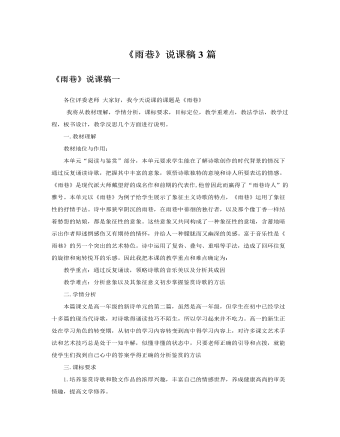
人教版高中语文必修1《雨巷》说课稿3篇
一.教材理解教材地位与作用:本单元“阅读与鉴赏”部分,本单元要求学生能在了解诗歌创作的时代背景的情况下通过反复诵读诗歌,把握其中丰富的意象,领悟诗歌独特的意境和诗人所要表达的情感。《雨巷》是现代派大师戴望舒的成名作和前期的代表作,他曾因此而赢得了“雨巷诗人”的雅号。本单元以《雨巷》为例子给学生展示了象征主义诗歌的特点,《雨巷》运用了象征性的抒情手法。诗中那狭窄阴沉的雨巷,在雨巷中徘徊的独行者,以及那个像丁香一样结着愁怨的姑娘,都是象征性的意象。这些意象又共同构成了一种象征性的意境,含蓄地暗示出作者即迷惘感伤又有期待的情怀,并给人一种朦胧而又幽深的美感。富于音乐性是《雨巷》的另一个突出的艺术特色。诗中运用了复沓、叠句、重唱等手法,造成了回环往复的旋律和宛转悦耳的乐感。因此我把本课的教学重点和难点确定为:教学重点:通过反复诵读,领略诗歌的音乐美以及分析其成因教学难点:分析意象以及其象征意义初步掌握鉴赏诗歌的方法
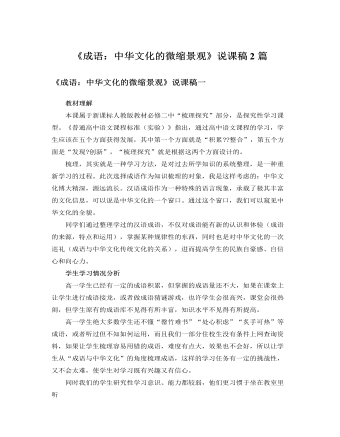
人教版高中语文必修2《赤壁赋》说课稿3篇
[教学反思]人教版高中语文必修二第三单元安排了《兰亭集序》《赤壁赋》《游褒禅山记》三篇古代山水游记散文,它们借游赏之事,探索生命的意义、治学的道理。师者,所以传道、授业、解惑也。高中的教材选用的都是历史经典名篇,每一篇都闪烁着儒道释等百家光辉的思想。编者要老师传道的意图很明显。即非如此,看着这些影响历代、影响世界的如日月之耀眼光华的伟大思想就躺在我们的教科书里,又如何能不讲呢?所以,我将本课的教学重难点拟定为:帮助学生建立积极的生死观,掌握多角度看问题的正确的思想方法。当然,也让学生领会了融写景、抒情、说理于一炉的大家手法。整堂课各教学环节,环环相扣,过渡自然,读、思、议、写训练到位,而且全部围绕“生死观”展开,如一篇形散神不散的散文。
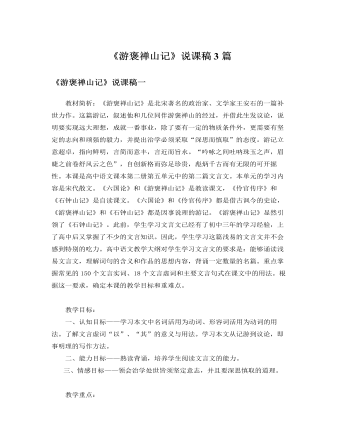
人教版高中语文必修2《游褒禅山记》说课稿3篇
学法指导:高一学生对文言文阅读已具备了一些基础知识和积累,但对如何学习文言文,还是一个新课题,因此教师应引导学生掌握学习方法,运用已有的知识框架同化新信息,建立新的智能,逐步走向独立学习的境界。一、引导学生利用课文注释,使用工具书自己翻译,必要时教师进行点拨、解难,培养自学能力。二、告诉学生翻译文言文要遵循的原则。三、调动学生思考、讨论、交流的积极性,教师适时点拨,培养学生发现问题、解决问题的能力。四、提示学生反复诵读课文,体会文章所阐述的道理。五、鼓励学生及时归纳学习文言文的方法,注意积累文言文知识。教学程序:教学本课可安排2课时。第一课时:1、导入新课:首先给学生介绍毛泽东的七绝诗《为李进同志题所摄庐山仙人洞照》:“暮色苍茫看劲松,乱云飞渡仍从容。天生一个仙人洞,无限风光在险峰。”学生通过诵读领会了“无限风光在险峰”一句的含义。随后因势利导,引出课题,指出今天我们要学习的王安石的《游褒禅山记》,就含有类似的深邃哲理。
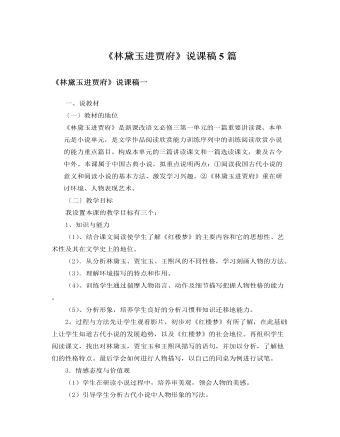
人教版高中语文必修3《林黛玉进贾府》说课稿5篇
【教学目标】我设置的本课的教学目标有三个:1、知识与技能(1)了解曹雪芹及《红楼梦》(2)学习通过一个人物的行踪、所见所闻,介绍典型环境,认识封建贵族阶级豪奢极耻的生活以及森严的等级、礼仪制度(3)分析小说人物出场的描写艺术,培养学生分析小说人物形象的能力。(4)一叶落而知秋”,通过对“林黛玉进贾府”这一故事情节的把握是否能引发对《红楼梦》的认知兴趣,并找到一个突破口,有针对性地进行自主探究,进而进行个性化解读。(5)整体认知小说,认识小说悲剧的必然性和思想价值.2、过程与方法(1)用直观演示和归纳探究法分析文章要点。(2)用讨论探究法体验作者对文中人物的情感态度。3、情感态度价值观(1)正确理解《红楼梦》的思想内涵,培养学生热爱祖国传统文化的思想感情。(2)认识封建大家族的腐朽没落,理解贾宝玉追求个性自由反封建的精神。
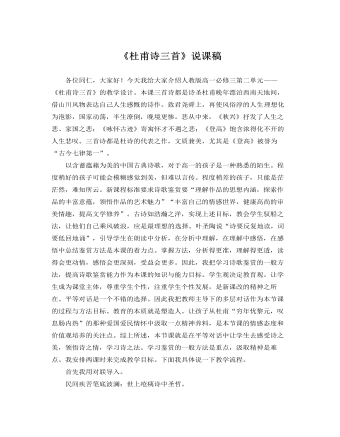
人教版高中语文必修3《杜甫诗三首》说课稿
我以以《登高》为例,引导学生进行意象分析,感悟意境美。古人云“立象以尽意”“古诗之妙,专求意象”意象是诗人情感的载体,是诗歌的灵魂。引导学生张开联想和想象的翅膀去感受,去体验是意象,诗歌鉴赏的关键。科林伍德说“真正艺术的作品,不是看见的,也不是听到的,而是想象中的某种东西。”诗人通过想象创造出诗的形象,我们读者通过想象丰富地再现诗人创造的形象。而感受体验则是以全部身心投入作品,心灵与心灵相沟通,感情与感情相交流,对诗人的想象活动进行再经历和再体验。因此,在引导意象解读中,我先让学生点击这一个,就是通过抓修饰词、依据感情基调、展开想象具体分析本诗中每个意象的情感意蕴和审美意蕴,使学生明白意象在每首诗中的独特性。
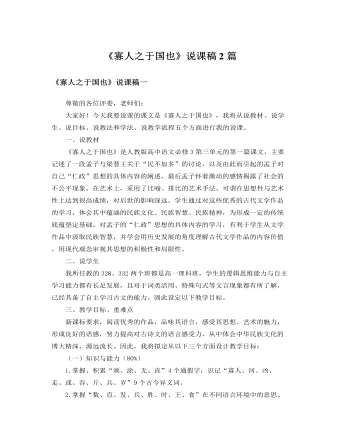
人教版高中语文必修3《寡人之于国也》说课稿2篇
(明确:“寡人之于国也,尽心焉耳矣”,但“寡人之民不加多,何也?”)②他认为自己对国家政务尽心尽力了,他有哪些具体做法?(明确:移民移粟)③第2—4节中孟子是怎样说明梁惠王移民移粟的措施与“邻国之政”并无本质区别的?(明确:孟子不直接回答“民不加多”的问题,而是用梁惠王熟悉的“战”设喻——设圈套,诱使对方在不知不觉中说出“不可,直不百步耳,是亦走也。”)④孟子认为怎样才能做到“王道之始”?要想“王道之成”还需采取哪些措施?(明确:“不违农时,谷不可胜食也。数罟不入氵夸池,鱼鳖不可胜食也。斧斤以时入山林,材木不可胜用也。谷与鱼鳖不可胜食,材木不可胜用五亩之宅,树之以桑,五十者可以衣帛矣。鸡豚狗彘之畜,无失其时,七十者可以食肉矣。百亩之田,勿夺其时,数口之家,可以无饥矣。谨库序之教,申之以孝涕之义,颁白者不负戴于道路矣。)这一小步的目的是想让学生通过这些问题的解答,可以进一步理清思路,掌握文的大概内容。
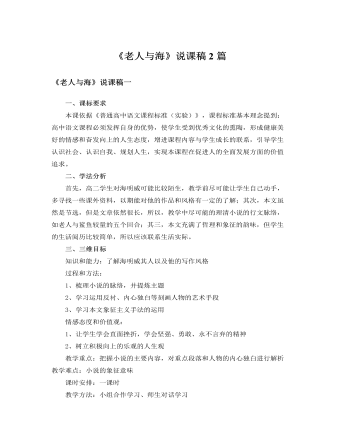
人教版高中语文必修3《老人与海》说课稿2篇
3、重要语句的理解“可是一个人并不是生来要给打败的,你尽可把它消灭掉,可就是打不败他。”解析:这是老人第一次回合之后的内心独白,也是此小说的核心精神,充分体现了老人桑地亚哥的生命理念。整句话可以分为两部分来理解,前句告诉我们,人生活在自然与社会当中,必不可少要面临一些坎坷、磨难,这些磨难、坎坷完全可以造成躯体的消灭、消亡,这是人生命的脆弱性。后句,面对挫折,只要保持一种乐观的精神,拥有一颗坚强的心灵,那么,人类执着奋斗的精神将永不磨灭。4、象征主义题目是《老人与海》,而表明上,小说是写一位老人及其在海上的经历,但实际上,老人的形象极具概括性,他已经超越了一个人的存在,而成为了人生的一种象征。老人桑地亚哥就是“硬汉子”的代表,大海则是生命旅途的象征,鲨鱼则是我们行走中的“强物”,厄运的象征。人的一生不可能一帆风顺,不经历风雨,怎能见彩虹,走在人生路途中,不可避免我们都要遇到挫折,被厄运所阻挠,只有经历与“鲨鱼”的较量,才能成为强者,唱出最美的歌。

